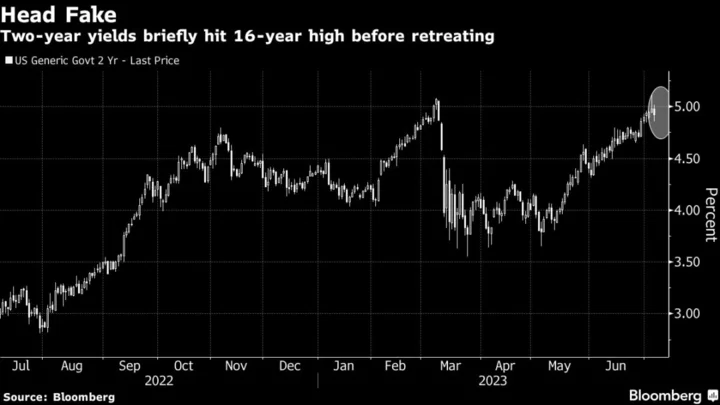On Thursday, a blowout jobs report pushed US yields to the highest in 16 years — unleashing fresh bets that Jerome Powell & Co. will ramp up borrowing costs well past 5%.
Just 24 hours later, Wall Street’s conviction is already fraying after headline nonfarm payrolls data came in a little soft, sending two-year yields back to Wednesday levels.
The volatility is raising a question in the bond community on why anyone would be tempted to trade the ADP monthly jobs data when it has — at best — a middling track record of jibing with the government data. The answer for the haywire moves, in all likelihood, is that a holiday-shortened week has conspired to reduce liquidity just as market positioning got crowded.
“The moral of the story is never trade on ADP data,” said Ed Al-Hussainy, global rates strategist at Columbia Threadneedle. “It’s just a poor lead on NFP. We had an unusually large market reaction yesterday reflecting a heavy flattener position and poor liquidity this week.”
Two-year yields surged as much as 17 basis points Thursday and hit 5.12%, a level last seen in 2007, after the data from ADP Research Institute showed US companies added almost half a million jobs last month, twice as much as economists forecast. It steadily retraced the move through the day as traders unwound the flattener trade — that short-term yields will rise faster than the long-end — which has proved popular on upbeat data.
The unwinding of the curve trade continued Friday, following the payroll report, with the gap between two-year and 10-year yields narrowing another 7 basis points.
The private job report, compiled by the ADP in collaboration with Stanford Digital Economy Lab, is known for its unsteady relationship with the official report. The monthly government payroll trailed the ADP report by more than 100,000 on average over the past three months, after beating it by 139,000 at the beginning of the year.
“The lesson we should learn and continue to learn is that you should never overreact to a single data point and yesterday’s market reaction appears to be that,” said Arthur Hogan, chief market strategist at B. Riley Wealth. “But I would also offer up that after a blistering-hot first half in markets, you may well have had investors looking for any excuse to take some profits. I think that’s OK — but just don’t blame a single data point for that.”
The ADP survey has a long track record of giving different signals from the official monthly jobs report, and its compilers have for some time sought to emphasize that they’re not aiming to match the Bureau of Labor Statistics series. ADP suspended its series a year ago to revamp its methodology, not the only change to the survey over the years.
To be sure, even the government gauges of the jobs market have lately offered different signals. Though the May BLS report showed an outsize gain in payrolls, its household survey showed the number of employees plunged that month.
In any case, Friday’s official data still gives ammo to those betting the US economy will continue to run hot, with stronger-than-expected wage growth for June — suggesting volatility in the Treasury market is set to endure.
“ADP never fails to fail!” said Rishi Mishra, an analyst at Futures First Canada, on Twitter.
--With assistance from Christopher Anstey.
(Updates with additional information on ADP data.)

